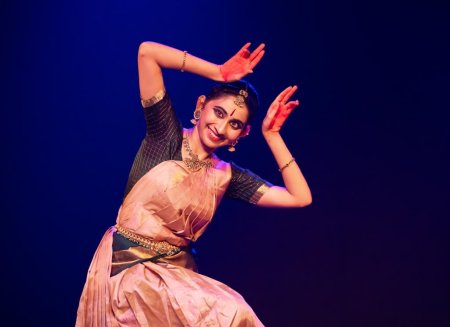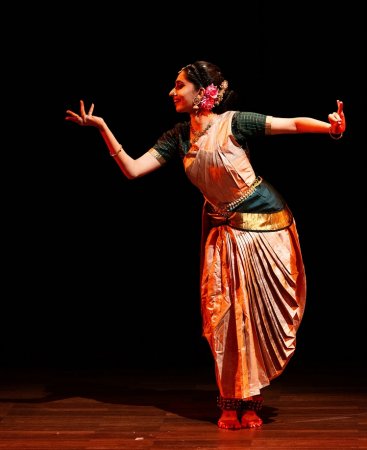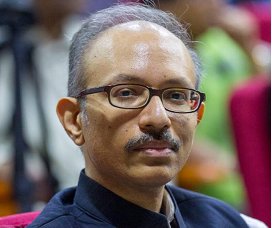
|   |

|   |
Kalyani and its daughter Raagas - G.V. Anna Rao e-mail: gvannarao@gmail.com September 5, 2024 Sahitya Ramkumar is rapidly making her name as an innovative and creative Bharatanatyam dancer in Hyderabad. Her undoubted talent will definitely take her places, as evidenced by the remarkable response to her productions. These performances are one of a kind and attract an overflowing audience. Her weekend ticketed solo program at Rangbhoomi on July 28, 2024 was sold out, which is no mean feat for a young artiste and is a testament to her credibility to deliver an outstanding performance. The title of this Sahityakalpa program, 'Ithi Kalyani,' summarised that the entire concept was devoted to the Queen of Ragas - Kalyani and allied Janya ragas, which share the regal name of their parent. They have the same foundation but emit a distinctly different flavour of their own. Serenely melodious, silvery, and sparkling in all its derivatives, Kalyani is a favourite raga for composers and listeners alike.  Photo: Chandrakala The novel idea of assembling an entirely new team of equally talented young orchestra members was a masterstroke. A fresh vibrance and enthusiasm were infused, radiating throughout the recital. The verve and vigour of this team were evident: Divyasri Pisupati, an upcoming vocalist with flair who promises to make her mark; Sai Venkata Gangadhar, a brilliant Kuchipudi dancer who essayed nattuvangam for a different dance form with elan; Koundinya Pannala, whose mastery of the violin added zest; and finally, the mridangam, played with incomparable wizardry by Veeramraju Lakshmi Ajay. The cost of a live professional orchestra has become prohibitive. The solution devised was to select talented young artistes to form a team with equal involvement and investment in effort to partner in the creation of the production. The credit for bringing together, monitoring, and superbly encouraging the entire team into giving their best must go to Sahitya. It should be understood that the effort put in by a dance orchestra is markedly different from that which performs for a concert. The demanding repetitions require a greater degree of coordination between different vocabularies to synchronise and achieve a complementing harmonious whole out of contrasting aural and visual realms. The aharya was pared down to essentials: a palette of sandal cream, aureate rose bordered with green containing traceries of gold made for a softly luminous and refined elegance. A touch of pink flowers to the headdress with minimum emerald-toned jewellery subtly added refinement. The artiste looked picture perfect and fascinated the audience as she resembled a chryselephantine (ivory & gold) statuette. Sahitya gave a brief intro incorporating mimed gestures at the start, summing up the forthcoming program and touching on its nuances, which was a poetic act and instantly achieved its aim of setting the mood for the viewers. The rasikas sat back and enjoyed the theme of love's blossoming and reveled in its beauty. Jatiswaram and Alarippu blended seamlessly as they had a matching cycle of seven beats in mishrachapu. In Mohana Kalyani, whose Aarohanam has the notes of raga Mohanam and Avarohanam Kalyani, the Jatiswaram was a treat to watch in its joyful and youthful stride. The Alarippu was reimagined to vividly depict the image of a blossoming flower, and while both pieces adhered to the traditional diction, their juxtaposition in this particular idiom was imaginatively reinvigorating. The sublime "Sarasi Jakshudu Neevani" varnam, a treasured priceless heirloom of Sivananda from the Tanjore Quartet, unfolded majestically. Its notation and lyrics were sourced from the ever helpful author, scholar, dancer and critic Jeetendra Hirschfeld. This baroque masterpiece was extensively re-choreographed with scintillating jathi sequences. It is structured as a love letter from the Nayika to her beloved Rajagopalaswamy. Sahitya's heightened mastery of abhinaya was outstanding as she portrayed the exquisite ornate imagery which described the beauty of the beloved Lord with lotus petal eyes who is yearned for passionately. A segment encapsulated the temple chariot procession rituals. Charanam "Gana Vidya Lola" gave ample scope as it was better expressed musically rather than through movement for a brief interlude of a stirring vintage thani or solo instrumental segments. Having said that, the movement vocabulary used in the rhythmic sections seemed repetitive at few places.  Photo: Suchitra Akella A rare Thillana by Muthaiah Bhagavatar in Hamir Kalyani was imagined to be done by the court dancer in praise of the King of Mysore admiring his valour. Karanas were exclusively interposed to make sculptural stances melt liquidly into successive poses. This lissome exhibition of mastery evoked applause. A bhajan in Yaman Kalyani was the last item in Swati Thirunal's inimitable stanzas soaked with devotion to Lord Padmanabha. Gopikas, the Yamuna river and all Brindavan are enthralled by the ravishing notes emitted by Krishna's flute. The tempo of the dance reached a stirring climax in the Rasleela played by Shyam. The perfect combination of a foundation from esteemed Guru Ramalinga Sastry, karana learning from tutor Vithya Arasu and abhinaya mastery learnt from teacher Dr. Anupama Kylas and her own talent came together for a dazzling performance. A standing ovation was given as the spellbound audience reluctantly awoke from the enchantingly lovely dream-like concept created by the artistes!  G.V. Anna Rao has been arranging classical dance programs and festivals for more than a decade in Hyderabad. He has also been reviewing dance performances for the Hans India Newspaper for many years. Having a keen interest in photography, many of the pictures taken by him have appeared in the Hindu's Friday Review occasionally. He is also a member of INTACH. |